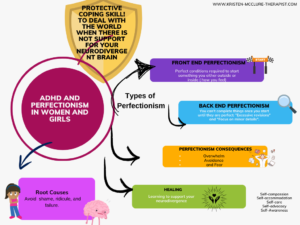
What are the connections between ADHD and perfectionism in women?
Perfectionism is reported to be the most common "cognitive distortion" in adhd women. On the surface, it might seem like it's just a bad thing, but it's a protective coping skill!
It makes perfect sense that adhd and perfectionism are so strongly related. In looking around and deciding how to help yourself as an overwhelmed neurodivergent child, you decided to do the best you can to prevent dire consequences.
As a girl, you wanted to avoid being shamed, made fun of, or experiencing failure. You learned this felt bad, and so you did what you could to not feel it. If you were perfect, you got rewarded!
Your perfectionistic tendencies likely worked. As a child, you may have appeared to adults to be diligent, skilled, and passionate about life.
But as you tried to prove your capabilities, sometimes working doubly hard compared to your peers, you may have laid the groundwork for other problems.
Perfectionism is highly related to masking, avoidance, procrastination, and fear. In my practice, I refer to perfectionism as an OLD coping skill.
ADHD women and girls use it to manage the neurotypical world because they don't have proper help or accommodations.
Perfectionism serves as a protective skill, aiming to shield adhd girls and women from criticism and feeling overwhelmed or making mistakes. It protects against the fear of becoming overwhelmed or failing. This drive for high standards is rooted in avoiding shame and criticism.

2. How can perfectionism manifest in ADHD women?
Front-End Perfectionism: This involves setting stringent rules or conditions that must be met before starting tasks.
Examples include being unable to begin a creative project unless the entire house is organized or believing one can't start a fitness routine without the perfect workout clothes and a sunny day.
Back-end perfectionism: This is characterized by an intense focus on correcting or improving tasks once they have begun. It might involve spending excessive time revising a project, fixating on minor details, or being unable to delegate tasks for fear they won't meet high standards. This is what we traditionally think of when discussing perfectionism in modern culture—having to do things " perfectly."
3. What are the strategies for managing perfectionism in ADHD women?
Embrace Self-Compassion: You did not deserve any of the shame or judgment that you experienced, and it makes perfect sense that you would develop perfectionistic tendencies as a way to protect yourself. Practice self-compassion and remind yourself that it is okay to make mistakes and that your level of perfection does not determine your worth.
Foster Self-Awareness: Differentiate between helpful rules and those that are restrictive. Ask yourself if you're trying to prevent feeling overwhelmed because you need to practice self-accommodation or if it's possible to start and do a small portion of the task. If you are having trouble getting started (front-end perfectionism) Are these symptoms of perfectionism or a sign that you need to accommodate yourself or alter the task?
Set Realistic Goals and Practice Self-Accommodation: Break tasks into smaller, manageable steps, work on masking less, and alter your environment so tasks are easier and friendlier to do for your brain, are things that are likely to help you to decrease perfectionism.
Are there any potential pitfalls to be aware of when managing ADHD and perfectionism?
When beginning to work on perfectionism, it is essential to remind yourself of its downsides.
Perfectionism can spiral into a counterproductive cycle, exacerbating issues like procrastination, anxiety, depression, and rejection-sensitive dysphoria. It can lead to a restricted life experience, where you lose sight of their values and strengths.
The fear of making mistakes can induce decision-making paralysis, emotional dysregulation, and even avoidance behaviors, resulting in a diminished quality of life.
However, it's important to distinguish between perfectionism and accommodation when talking about front-end perfectionism.
Similarly, it's important to distinguish between symptoms of perfectionism, both back-end, and front-end and help yourself to do a good job or feel comfortable doing a task. Here are some ways to tell the difference.
Front-End Perfectionism:
This type of perfectionism involves setting strict conditions that must be met before starting a task. It often leads to procrastination and task paralysis.
Writing a Report:
Front-End Perfectionism: Believing you can't start writing until you've read every possible resource on the topic, leading to never actually beginning the report.
Self-Accommodation: Set aside a few essential resources to start and allow yourself to dive into the writing process, knowing you can refine it later. Make sure it's quiet and the room is organized so you can focus.
Starting a Fitness Routine:
Front-End Perfectionism: Feeling you can't begin exercising until you have the perfect set of workout clothes, the best equipment, an ideal fitness plan, and a sunny day.
Self-Accommodation: Start with basic exercises at home, using what you have, and gradually build up your routine. Ensure the house is quiet and you have no interruptions so you can finish the task when you start.
Painting a Picture:
Front-end perfectionism: believing you can't start painting until you take advanced art classes or have the perfect inspiration.
Self-Accommodation: Beginning with a simple sketch or painting exercise to get the creative juices flowing. Make sure it's a neat room so you can focus, make sure you aren't interrupted while painting so you can complete the task.
Back-End Perfectionism:
This involves an obsessive focus on refining or correcting tasks once they've begun, often leading to excessive revisions and an inability to consider a task "finished."
Writing a Report:
Back-end perfectionism: After writing, one spends disproportionate amounts of time revising and re-revising, never feeling satisfied with the end product.
Being Conscientious means reviewing the report for clarity and errors, making necessary edits, and then submitting it in a timely manner. You should also ask someone to proofread your report because you tend to make careless errors.
Completing a Fitness Routine:
Back-End Perfectionism: After a workout, feeling it wasn't good enough and pushing yourself to do more and more exercises, leading to potential burnout or injury.
Being Conscientious means reflecting on the workout, noting areas for improvement, and planning adjustments for the next session.
Painting a Picture:
Back-end perfectionism involves continuously tweaking and adjusting the painting, never feeling it's complete or good enough to show others.
Being Conscientious means taking a step back to review the artwork, making a few adjustments if needed, and then feeling content with the result.
5. How can parents be aware of perfectionism developing in ADHD children, specifically girls, and help support them?
It's a theme in my practice to work with mothers to help make sure patterns don't develop in their daughters EARLY. This way, we can head off some of the struggles that they went through. You can definitely help prevent perfectionism from developing in your children by working hard to combat the things that give rise to it.
Parents can be vigilant about signs like excessive self-criticism, reluctance to start tasks without specific conditions, or spending too much time on a task due to fear of making mistakes. Open communication, understanding, and encouragement can help support them. Encouraging self-compassion and resilience while challenging unrealistic standards can be beneficial.
6. What kinds of therapy can support ADHD people with perfectionism?
While Cognitive Behavioral Therapy (CBT) can be particularly effective, it's crucial to approach it with caution for ADHD women. They often use front-end perfectionism as a skill to prevent themselves from feeling too overwhelmed. It's essential to work with a skilled CBT therapist who understands masking and neurodivergence; otherwise, they can exacerbate the issue. Therapies that focus on self-compassion and mindfulness can also be beneficial.
Note: The neurodivergent communities have horrible experiences with CBT. They experience it as invalidating and "gaslighting." If you have an experience that feels off or makes you feel much worse, please either switch therapists or get a new one. Therapy should feel good, validating, and safe.
7. What kind of lifestyle changes can support ADHD people with perfectionism?
Perfectionism is a compensatory mechanism. This means that it's developed to compensate and protect you for the way you have been meant to feel deficient. Which you are not.
It's hard to help yourself feel different in a society that doesn't embrace and support you. Still, it's essential to set your life up and surround yourself with people who make you feel like your neurodivergence is something to celebrate.
This allows you to feel safe enough to unmask and begin letting go of perfectionism.
Are there any resources or support groups available for women with ADHD and perfectionism?
For more guidance and support on managing ADHD and front-end perfectionism, please join the community or message at kristenlynnmcclure@gmail.com. A course and workbook are also available for those interested in exploring the topic further.
Learn more about adhd and perfectionism here.
Kristen McClure: Neurodivergent-Affirming ADHD Therapist and Coach with 30 years experience in North Carolina and South Carolina Offering virtual therapy and coaching services across North Carolina, including Ashville, Raleigh, Durham, Wilmington, Greenville, and more. Also serving major South Carolina cities such as Charleston, Columbia, Greenville, Spartanburg, Rock Hill, and more.


